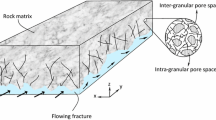Abstract
Deep low-permeability clay layers are considered as safe environments for disposal of high-level radioactive waste. In Belgium, the Boom Clay is a candidate host rock for deep geological disposal. In this study, we analyze the effects of fractures and spatially variable hydraulic conductivity on radionuclide migration through the clay. Fracture geometry and properties are simulated with Monte Carlo simulation. The heterogeneity of hydraulic conductivity is simulated by direct sequential co-simulation using measurements of hydraulic conductivity and four types of secondary variables. The hydraulic conductivity and fracture simulations are used as input for a transport model. Radionuclide fluxes computed with this heterogeneous model are compared with fluxes obtained with a homogeneous model. The output fluxes of the heterogeneous model differ at most 8% from the homogeneous model. The main safety function of the Boom Clay is thus not affected by the fractures and the spatial variability of hydraulic conductivity.











Similar content being viewed by others

References
Andersson P, ByegÅrd J, Tullborg EL, Doe T, Hermanson J, Winberg A (2004) In situ tracer tests to determine retention properties of a block scale fracture network in granitic rock at the Äspö Hard Rock Laboratory, Sweden. J Contam Hydrol 70(3–4):271–297
Bear J (1972) Dynamics of fluids in porous media. American Elsevier, New York
Dehandschutter B (2002) Faulting and Fracturing during Connecting Gallery tunnelling at the URL at Mol (SCK-CEN). ONDRAF/NIRAS internal report, Brussel, Belgium
Dehandschutter B, Sintubin M, Vandenberghe N, Vandycke S, Gaviglio P, Wouters L (2002) Fracture analysis in the Boom Clay (URF, Mol, Belgium). Aardkundige Mededelingen 12:245–248
Dehandschutter B, Vandycke S, Sintubin M, Vandenberghe N, Gaviglio P, Sizun JP, Wouters L (2004) Microfabric of fractured Boom Clay at depth: a case study of brittle-ductile transitional clay behaviour. Appl Clay Sci 26(1–4):389–401
Deutsch CV, Journel AG (1998) GSLIB geostatistical software library and user’s guide. Oxford University Press, New York
Harrison B, Sudicky EA, Cherry JA (1992) Numerical analysis of solute migration through fractured clayey deposits into underlying aquifers. Water Resource Res 28(2):515–526
Horseman ST (2001) Self-healing of fractures in argillaceous media from the geomechanical point of view. In: Self-healing topical session proceedings, 11th Clay Club meeting, Nancy, OCDE/NEA, Paris
Isaaks EH, Srivastava RM (1989) An introduction to applied geostatistics. Oxford University Press, New York
Landais P (2004) Clays in natural and engineered barriers for radioactive waste confinement. Appl Clay Sci 26(1–4):1
Mallants D, Sillen X, Marivoet J (1999) Geological disposal of conditioned high-level and long lived radioactive waste: consequence analysis of the disposal of vitrified high-level waste in the case of the normal evolution scenario. Ondraf/Niras report R-3383, Brussel, Belgium
Mallants D, Marivoet J, Sillen X (2001) Performance assessment of vitrified high-level waste in a clay layer. J Nucl Mater 298(1–2):125–135
Mertens J, Wouters L (2003) 3D Model of the Boom Clay around the HADES-URF. NIROND report 2003–02, Brussel, Belgium
Mertens J, Bastiaens W, Dehandschutter B (2004) Characterization of induced discontinuities in the Boom Clay around the underground excavations (URF, Mol, Belgium). Appl Clay Sci 26(1–4):413–428
Oz B, Deutsch CV, Tran TT, Xie Y (2003) DSSIM-HR: a FORTRAN 90 program for direct sequential simulation with histogram reproduction. Comput Geosci 29(1):39–51
Pohlmann K, Hassan A, Chapman J (2000) Description of hydrogeologic heterogeneity and evaluation of radionuclide transport at an underground nuclear test. J Contam Hydrol 44(3–4):353–386
Rudolph DL, Cherry JA, Farvolden RN (1991) Groundwater flow and solute transport in fractured lacustrine clay near Mexico City. Water Resource Res 27(9):2187–2201
Therrien R, Sudicky EA (1996) Three-dimensional analysis of variably-saturated flow and solute transport in discretely-fractured porous media. J Contam Hydrol 23 (1–2):1–44
Therrien R, Sudicky EA, McLaren RG (2003) FRAC3DVS: an efficient simulator for three-dimensional, saturated-unsaturated groundwater flow and density dependent, chain-decay solute transport in porous, discretely-fractured porous or dual-porosity formations, User’s guide
Vandenberghe N, Van Echelpoel E, Laenen B, Lagrou D (1997) Cyclostratigraphy and climatic eustacy—example of the Rupelian stratotype. Comptes Rendus de l‘Academie des Sciences. Earth Planet Sci 325:305–315
Wemaere I, Marivoet J (1995) Geological disposal of conditioned high-level and long lived radioactive waste: updated regional hydrogeological model for the Mol site (The north-eastern Belgium model). ONDRAF/NIRAS Report R-3060, Brussel, Belgium
Wemaere I, Marivoet J, Labat S, Beaufays R, Maes T (2002) Mol-1 borehole (April-May 1997): core manipulations and determination of hydraulic conductivities in the laboratory. ONDRAF/NIRAS Report R-3590, Brussel, Belgium
Wouters L, Vandenberghe N (1994) Geologie van de Kempen: een synthese. ONDRAF/NIRAS Report NIROND-94–11, Brussel, Belgium
Xu S, Worman A, Dverstorp B (2001) Heterogeneous matrix diffusion in crystalline rock—implications for geosphere retardation of migrating radionuclides. J Contam Hydrol 47 (2–4):365–378
Acknowledgements
The authors wish to acknowledge the Fund for Scientific Research—Flanders for providing a Research Assistant scholarship to the first author. We also wish to thank ONDRAF/NIRAS (Belgium agency for radioactive waste and enriched fissile materials) and SCK-CEN (Belgian Nuclear Research Centre) for providing the necessary data for this study. We also thank René Therrien and Rob McLaren for providing FRAC3DVS and for their assistance.
Author information
Authors and Affiliations
Corresponding author
Rights and permissions
About this article
Cite this article
Huysmans, M., Dassargues, A. Stochastic analysis of the effect of heterogeneity and fractures on radionuclide transport in a low-permeability clay layer. Environ Geol 48, 920–930 (2005). https://doi.org/10.1007/s00254-005-0030-2
Received:
Accepted:
Published:
Issue Date:
DOI: https://doi.org/10.1007/s00254-005-0030-2



